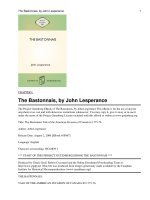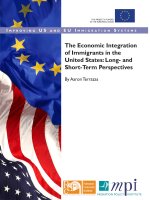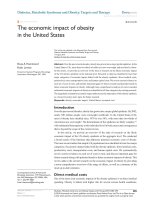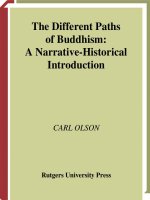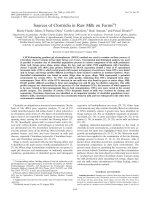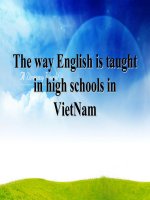The ecological spirit of buddhism in Vietnamese stories on animals written after 1986
Bạn đang xem bản rút gọn của tài liệu. Xem và tải ngay bản đầy đủ của tài liệu tại đây (335.99 KB, 9 trang )
TRƯỜNG ĐẠI HỌC SƯ PHẠM TP HỒ CHÍ MINH
HO CHI MINH CITY UNIVERSITY OF EDUCATION
TẠP CHÍ KHOA HỌC
JOURNAL OF SCIENCE
KHOA HỌC XÃ HỘI VÀ NHÂN VĂN
SOCIAL SCIENCES AND HUMANITIES
ISSN:
1859-3100 Tập 16, Số 7 (2019): 64-72
Vol. 16, No. 7 (2019): 64-72
Email: ; Website:
Research Article
THE ECOLOGICAL SPIRIT OF BUDDHISM IN VIETNAMESE
STORIES ON ANIMALS WRITTEN AFTER 1986q
Bui Thanh Truyen
Ho Chi Minh City University of Education
Corresponding author: Bui Thanh Truyen – Email:
Received: April 03, 2019; Revised: May 11, 2019; Accepted: June 10, 2019
ABSTRACT
Being a widely-known and long-standing religion, the ecological spirit of Buddhism
explicitly expresses its topicality and significance in this changeable and vulnerable world.
Compassion and respect to all species’ lives; the perception of giving up all lusts and greeds to
create the environment and the universe; and ecological enlightenment are Buddhist
characteristics identified in Vietnamese stories about animals during the Đổi mới (Renovation)
economic reforms.
Keywords: Buddhism, ecology, short stories, novels, animals, after 1986.
1.
The relationship between Buddhism and ecological criticism
Buddhism is one of the ten biggest religions in the world1. Four out of ten countries with
the highest number of Buddhists belong to East Asia: China, Japan, Viet Nam and South
Korea2. This is one of the most important factors that lead to a close-knit relationship and a
share in cultural, physical and mental features among East Asian countries.
Compared to Confucianism, Buddhism and literature share a closer thinking because
Buddhism is more intuitive and spiritual, while Confucianism is more rational. One of the
important aims of Buddhism is to encourage supernatural power to bring about changes or
changes prevention for humans and nature (Vũ Minh Chi, 2004, p.276). In essence,
Buddhism expresses the idea of featuring adaptability and peace in humans when facing all
changes and transformations of nature and the society. Buddhism approaches the
environment and nature from an ethical and philosophical viewpoint. Buddhism’s ideology
embodies thoughts on ecology. The Giới sát (prohibition of killing) undertaking proposed
by Buddhism has shown humans’ respect and love towards all beings regardless of living
or non-living. The Dependent Origination theory (Duyên khởi luận) from Buddhism also
points out the causality of everything in the world, that mutual dependence is a
fundamental rule of nature. Between humans and nature lies a mutual relationship, in
Cite this article as: Bui Thanh Truyen (2019). The ecological spirit of Buddhism in Vietnamese stories on
animals written after 1986. Ho Chi Minh City University of Education Journal of Science, 16(7), 64-72.
1Including Buddhism, Christianity, Protestantism, Islam, Judaism, Hinduism, Jaina, Confucianism, Taoism
and Shinto.
2According to 2010’s record, these countries’ numbers of Buddhists are as followed: Taiwan: 8,000,000
(35% of its population); South Korea: 11,050,000 (22%); Japan: 45,820,000 (36.2%); China: 244,130,000
(18.2%); Viet Nam: 14,380,000 (16.4%).
64
Tạp chí Khoa học Trường ĐHSP TPHCM
Bui Thanh Truyen
which they impact each other. The creature circle is an inseparable and well-proportioned
whole and a well-organized operation. Humans depend on nature to survive, while nature
is regarded as the inorganic body of human (Thich Nhuan Dat, 2010, p. 9).
Appreciation and protection of the environment is the principle of most religions
including Buddhism. In the United Nations Environmental Programs, religions are
considered the largest non-governmental organizations on the planet which are willing to
cooperate with religious communities in dealing with environmental issues (Đo Lan Hien,
2017). Protecting the environment is part of the Buddhist philosophy of life in modern
society. This is a significant basis for Buddhism and ecological criticism, a cross-sectoral
research approach originated from the UK and the US in the late 20th century when there
was a severe worldwide environmental crisis, to become more inter-related by a common
aim, that is to learn about the environment, sustainable development and human society
and to draw towards humanity and equality. Current literary research from the perspective
of ecological criticism often follows two aspects: natural ecology and mental ecology. The
former aspect usually pays attention to the interaction between humans and the natural
environment, thereby giving out messages and warnings about ecological threats. The
latter aspect focuses on the relationship between religion and the thoughts concerning the
environment, manifested in the following realms: indigenous intelligence, religious belief
and spiritual awakening (Bui Thanh Truyen, 2018, p. 163-171).
The inter-relationship between religion, literature and the environment has been
discussed for long. Approaching literature from the perspective of Buddhist ecology is
both familiar and unfamiliar at the same time. It is familiar because religion has naturally
accompanied the creation of humans and their society. Yet it is unfamiliar because the
natural and social biosphere with various qualities and complicated relationships in today’s
context has been the primary concern of different sciences, including literary, to contribute
to the sustainable development of mankind.
Vietnamese stories written since Đổi mới (1986) until now on the topic of animals
does not only accuse humans of their cruelty and irresponsibility towards ecology but also
gives warnings about ecological threats and encourages us to show our attention and
responsibility to our nature by adjusting our awareness and behaviors towards the
environment to better deserve the honorable title “Người ta – Hoa đất” (Humans are
flowers growing from the land of nature). The response of the art of words to the
environment through the lens of Buddhism is a critical ideology expressed in contemporary
Vietnamese prose. The idea has made this writing method clearly show its modern and
traditional quality, ethnicity and humanity, while representing the writer's sensitivity,
bravery, conscience and civic responsibility towards social situation of today with the
“literature answering nature’s calls” spirit.
Representation of Buddhist ecological spirit in Vietnamese stories about animals is
diverse in terms of category and degree. The word limit only allows this article to clarify a few
basic and outstanding points including […]. This is also an experiment on animal studies, one
of the prevailing trends in contemporary cultural research (Axel Goodbody, 2016, p. 252).
65
Tạp chí Khoa học Trường ĐHSP TPHCM
Tập 16, Số 7 (2019): 64-72
2.
Compassion and respect to all species’ lives
Buddhism teaches people to have mercy on everything. That is the benevolent and
compassionate attitude of humans towards all living beings, the act of being kind to animals to
protect the lives of all species and humans themselves. Gautama Buddha before his
Enlightenment was also reincarnated in many life forms from humans, deities to animals and
plants with the aim of understanding the life of all species in the natural world. The nucleus of
compassion is an “equal and indistinguishable attitude” (Duc Dat Lai Lat Ma, 2015, p. 58). All
beings deserve to have an equal existence value. Human existence is guaranteed when humans
live in harmony with all living beings and the world. In order to be eligible for the moral
responsibility of respecting all forms of life, people should embrace the aesthetic philosophy of
Buddhism “Vật ngã nhất như” (all beings are one and the same) and practice the principle of
living “Ái vật hộ sinh” (love and guard the lives of all beings). Having transformed the idea of
viewing animals as a resource for humans into a more reflective approach with animals being
viewed as an important part of lives on Earth, Vietnamese stories during Đổi mới has shown
the decentralization of post-modern literature. Animals were not seen and judged by humans
but had their own point of view and judgement towards humans. In a work by Nguyễn Huy
Thiệp, Muối của rừng, the look from the monkeys unmasked the true nature of the character:
“It would be a mess if they know I’m human!”; “They know old people are prone to be
touched”. Mr. Diểu, who is so stately at the beginning, becomes a “detestable”, “absurd”,
“abject” “murderer”, and “a laughing stock” for others. Only the seasoned hunter remains
ignorant in front of “the nature full of unexpected incidents”.
Sister and brother Nương and Điền in Cánh đồng bất tận by Nguyễn Ngọc Tư, who
lost themselves in the human world, come to the ducks to be shared, listened to and
understood because only the ducks can soothe the extreme pain that humans brought to
them. Mại (Trở lại với người – Võ Diệu Thanh) lost faith in other people, so she raised
dogs and befriended with them. Humans come to animals in order to find the good in
nature, begging nature to heal their wounds. Lowering the position of humans and exalting
loyal animal friends, the story is a wake-up call about the exhaustion of humanity and
loneliness of humans in today’s world. Chiếc vòng cổ màu xanh (Đặng Chương Ngạn)
strongly impresses readers by showing deep sympathy and gratefulness towards the dogs.
The characters Kẹo, Bông, Vàng, Cúc, Khoang, Xồm, Vàm… more or less will help us
reflect on our awareness, realize our inferiority, incompleteness and thereby adjusting our
perception, behaviors to coexist with all living beings in a world of love and equality. Rùa
in Ngồi khóc trên cây (Nguyễn Nhật Ánh), an orphan, a gentle and kind girl full of dreams,
who wholeheartedly love the forests despite her own safety, is therefore trusted and
protected by the forests. This literary work has harmonized the relationship between the
human world and animals, praising the perceptiveness and kindness of nature. In today's
society, while many people are passionate about materialism and underrate or neglect the
spiritual values, the "wise" farm animals in Chúc một ngày tốt lành of Nguyễn Nhật Ánh
bring a wake-up call to us: Even animals know how to appreciate their family, those who
reject that sacred kind of love is nothing to compared with a little pig.
66
Tạp chí Khoa học Trường ĐHSP TPHCM
Bui Thanh Truyen
Animals exist out of humans’ prejudice and subjectivity. Birds, animals, cattle and
poultry have their own lives, their own values and are equal to humans. We treasure our
own lives, and we should beware that nature has its own life, too. This is what Vietnamese
contemporary novels and short stories have in common (Phiên chợ Giát - Nguyễn Minh
Châu, Chó Bi đời lưu lạc - Ma Văn Kháng, Con thú lớn nhất, Muối của rừng, Trái tim hổ,
Sói trả thù - Nguyễn Huy Thiệp, Bi kịch con khỉ - Bảo Ninh, Jô - Y Ban, Tâm hồn chó Hòa Vang, SBC là săn bắt chuột - Hồ Anh Thái, Hóa kiếp - Tạ Duy Anh, Con hổ mun Đặng Thư Cưu, Biển và chim bói cá - Bùi Ngọc Tấn, Con gấu - Khuất Quang Thụy, Cá
sống - Nguyễn Ngọc Thuần, Chim phóng sinh - Nguyễn Hồ, Mổ heo, Người nói tiếng chim
bồ câu - Mạc Can…). It is the writer’s responsibility to listen to and share with all species
about their own fate. It seems that the writers feel the pain of any being in the world, and
when that pain is unbearable, the words will pop out. Literary works bring people closer to
animals with a gentle look, to cherish them, to learn about them and to love them.
Unlike the literature of the previous period when humans saw themselves as
superiors in the process of rehabilitating nature and building nations, they now often place
themselves in the position of “non-human”, transform themselves into animals to view and
judge humans and their society through the eyes of animals. The “vật ngã đồng nhất” (all
beings are one and the same) manner clearly demonstrates the changes in conceptions,
emotions, attitudes and actions of humans towards the environment. Personification and
legendization give the non-human characters human qualities as a counterpart to enlighten
readers. Using animals’ mindset to produce statements in the stories, the writer manages to
discover other aspects of humans: non-sacred, stuck in their illusion of superiority, thereby
hoping for the dream of living in harmony with nature to come true. In Ó ma lai (Hoàng
Văn Bổn), humans, animals and plants are sociable and sympathetic to each other. A
combination of reality and fantasy is an important factor for writers to raise a thoughtprovoking topic: the love for animals, the appreciation and protection for the environment,
the harmonized and friendly life with nature and animals: “Mr. Elephant, Mr. Tiger or even
some kinds poisonous snakes are all the same. If we are nice to them, they will be nice to
us”. Bí mật giữa tôi và thằn lằn đen (Lý Lan) also gives a strong impression through the
equality and community lifestyle among all species expressed in the story. Every living
being, whether tiny or giant, is valuable and meaningful in their own way in the diversity
of ecology. “A species would either live in the air, on the land or under water. It does not
matter, as long as it has the will to survive”. It is a “secret” worth being respected and
recognized. Understanding, praising and loving other species who are weaker than humans,
is a way for us to affirm our superiority. “The most superior species is not one that destroys
other species unnecessarily and thoughtlessly, but one that really works to protect other
species while still advancing on their own evolution, one that is truly mature and possesses
a sense of responsibility” (Nguyen Hoang Anh Thu, 2017).
Leading the food chain makes people forget that they are just one of the millions of
creatures sharing the Earth together, and that each species is equally important in the
ecosystem. This drives them into the unstoppable killing of other species without a sense
of compassion or protection. The compassion for animals in contemporary stories is a state
67
Tạp chí Khoa học Trường ĐHSP TPHCM
Tập 16, Số 7 (2019): 64-72
of mutual sympathy between humans and animals. Minimizing the pain for animals is a
representative value of civilization in the globalized world. The respecting animal’s right
attitude is proportional to the cultural and educational development of a nation. These
works show that people do not perceive nature as an object but consider themselves to be a
part of the natural world; people together with nature and all living beings share a close
bond and empathy. The words have cultivated compassion and mercy in readers so that
they could see enlightening flowers blooming in their hearts, eliminated evil thoughts to
cultivate kindness, creating a “new world order”. The idea of praising the non-humans as
humans derived from the “vạn vật nhất thể” (all beings are one and the same) of
Buddhism. “If we are aware that we and other creatures share the same nature, there will
be no separation or discrimination, and we will live peacefully together with all species
and nature” (Thich Nhat Hanh, 2010, p. 61).
3.
The perception of giving up all lusts and greeds to create the environment and
the universe
According to Buddhist philosophy, protecting lives while doing no harm to other
species is called “righteous karma”. Being aware of the sufferings caused by the act of
killing, people do not kill, do not approve of the act of killing and do not allow others to
perform that act, neither in the mind nor in real life; instead, they learn how to love and
protect the life of all beings. “Bringing joy to all species; that is righteous karma” (Nhất
Hạnh, 2018, p. 195). The Buddhist ban on killing is also the thorough protection human
and animal rights. In addition, Buddhism also encourages its devotees to implement the
philosophy of life called “thiểu dục, trí túc” (less desire, more wisdom) to reduce the
pressure that humans put on the environment and natural resources and to abstain from
greed, anger consumption and enjoyment to contribute to the protection of the ecosystem
and strengthen the bond between humans and nature.
Excluding those who are vegetarian, in order to survive substantially, humans have
to kill other animals for meat. Killing to survive is one thing, but killing to satisfy one’s
selfishness, individualism and overwhelming lust, which are expressed in Muối của rừng,
Sói trả thù, Trái tim hổ (Nguyễn Huy Thiệp), is a different story. It is the destruction of the
environment, self-destruction and the destruction of humans. It is necessary to distinguish
these two aspects in order to figure out the proper way we should treat animals, to touch
the spirit and the ecological writing style of contemporary literature. In Muối của rừng, the
obvious purpose of the Mr. Diểu's hunting is to seek a wave of euphoria. He takes the
initiative to enjoy that kind of pleasure. Only when bitterly defeated by the monkeys’
devotion, loyalty, sacrifice, nobility and vitality and returning empty handed does he
realize his smallness, helplessness and uselessness when causing trouble with nature.
Hoàng Văn Nhân and his precious son in the Sói trả thù hunt to maintain their family’s
tradition and reputation. These people deserve the worst consequences on themselves due
to their selfish actions that do harm to nature.
In the market economy era, the growing desire to enjoy wildlife cuisine of people
leads to the supply-demand whirlwind, making many creatures fall into the edge of
68
Tạp chí Khoa học Trường ĐHSP TPHCM
Bui Thanh Truyen
extinction. Things that no one cared about in the past now become famous specialty, are
mercilessly slaughtered. Bay cao thì mặc bay cao (Nguyễn Trí) mentions the killing of
birds for meat; after only one night, thousands of innocent birds are killed. In Những bầy
mèo vô sinh (Mạc Can), the storyteller pitifully wrote: “The doves must be extremely
painful knowing that people would commend their meat for being delicious”. It is the
uncontrollable greed and insatiable desire in human behaviors towards animals that turn
human life into a hostile world, where we are both victims and villains. The virus of
ignorance and indifference towards all species also leads to devastating consequences,
more or less in a same way as incurable or infectious diseases do.
Buddhism explains the importance of protecting the environment using the concept of
karma and nemesis. The karma motif in stories about animals is a vivid demonstration of
causality in the Buddhist worldview and the ecological cycle (Con thú lớn nhất, Trái tim hổ,
Sói trả thù - Nguyễn Huy Thiệp, Mùa đại bàng - Ngô Tự Lập, Ông Thiềm Thừ - Trần Kim
Trắc, Trái tim con rắn - Nguyễn Đông Thức, Cuộc báo thù cuối cùng - Cao Duy Sơn, Động
núi - Võ Diệu Thanh, Đồ tể - Nguyễn Trí, Đổi mặt - Nguyễn Vĩnh Nguyên, Đời cá Hô, Thần
khẩu hại xác phàm - Trần Bảo Định…). Động núi tells the story of the snakes exacting
revenge when they lost their habitat and when humans were trying to kill them. That's how
nature reacts to such heartless attitudes and unstoppable greed. Đổi mặt tells the story of a
person who eats a lot of dog meat and later turns into a dog. “Under the glowing high-voltage
light at night, I found my body full of hair, I could not speak, I saw myself howling with lust
all over my body. [...] I was in a dog life”. In Con thú lớn nhất, a hunter who spends his whole
life killing wild animals ends up becoming a duplicate of the Grim Reaper: the face becoming
sharper, the nose resembling a bird’s nose, the eyes becoming dimmer and deep-set, spreading
bleak phosphorous rays. In the end, all he could do is to kill himself with the last gunshot. In
Trái tim hổ, those who chase after fantasies and myths, when making mistakes with nature,
innocently though, still have to pay for their mistakes with their own lives.
The ecological spirit in stories written about animals harmonizes with the
compassion of Buddhism. It is expressed in concept of “one good turn deserves another,
the evil begets evil” (A good turn deserves another, curses come home to roost). Their
topicality, humanity and modernity have been well-determined. The stories help readers
raise their self-awareness, changing the mindset from devastating and destroying other
species to cherishing and protecting them and the environment, bringing a peaceful life to
all species, not dishonestly trade others’ sufferings for one’s own advantage.
These stories show that, nature has long been hiding mysterious powers, both charming
and brutal, which are ready to devote and destroy at the same time. Spiritualizing nature,
praising its mysterious power are metaphors of the desacrilisation of “the human center thesis”.
Although these are hypothetical worlds, depriving from the writer's imagination and feelings,
but by a simple reflection to reality, readers can realize that they are the near future of the
world. That is similar to a Czech writer’s opinion about his novel Khi loài vật lên ngôi: “This is
not fantasy but reality. This is not a speculation of what the future will be like, but a reflection
of what exists and what we are living together with. This is not a myth, which I can give away
whenever you want to whoever you are. This is reality” (Karel Capek, 2017, p. 6). Stories
69
Tạp chí Khoa học Trường ĐHSP TPHCM
Tập 16, Số 7 (2019): 64-72
written on the topic of animals are the proof of Vietnamese authors working together to write
about world disasters and the end of humanity.
4.
The ecological enlightenment
In Buddhism, enlightenment is a sudden awakening that could bring about changes to
one’s thinking and behaviors for the rest of their life. For example, in Người đi săn và con
vượn (Lev Tolstoy), having witnessed the touching moment when the mother ape does one
last favor for her children, the hunter breaks the crossbow and quietly returns; from then
on, he never goes hunting again. We encounter a similar detail in Ngồi khóc trên cây by
Nguyễn Nhật Ánh through Mr. Bốn Lai’s act of throwing a rifle into the fast-flowing river.
Afterward, he stops hunting to become a benevolent man, a Fairy God Father in the
children’s eyes. This awakening moment, which only lasts for a very short period of time,
1/4,800,000 of a full day, often exists in stories written about animals, marking a striking
aesthetic hit to the plot, thereby leaving a long-lasting impression in readers.
The image of an invisible eagle with a terrified scream being shot makes Động
suddenly think of “the bloody eyes of Vận in the old days”, which drives him to accuse
himself as “a bad player, a deceiver and even a betrayer” (Mùa đại bàng – Ngô Tự Lập).
This detail allows readers to understand that killing nature also means killing our own
friends. In Muối của rừng (Nguyễn Huy Thiệp), the moment when the character relieves
the monkey is also the moment he realizes “how heavy the responsibility that each creature
carries on their shoulders should be”. And also in that moment, the miracle of nature
occurs: Salt flower - the salt of the forest, blossoms after a three-decade cycle as a signal of
peace and prosperity. At the end of the story, the shadow of the character turns blurred in
the rain; the awakening moment has brought him back to nature to be purified. In Sói trả
thù, when Hoàng Văn Nhân frees the wolf that bites his only son to death, he eventually
understands the price he is paying for his wrongdoings to the animals. Karma never
exhausts. Causing trouble to nature only brings misery and suffering to humans.
Facing the eternity and wisdom of animals - a part of Mother Nature, who is full of
benevolence and compassion, humans eventually figure out how small and fragile their
lives are and how meaningless their wrongdoings are. Being suddenly awakened will
enlighten one’s ego, purify one’s soul, encourage one to act for the environment:
indifference and ignorance towards the surroundings shows irresponsibility to oneself and
the community; devastating living beings, destroying the environment is to destroy one's
life and their own species. Knowing how to respect the lives of animals, the writer cares
for the animals around him as a friend. With these awakening moments, animals have
become our counterparts, who we, humans, can look at to reflect, criticize and realize our
weaknesses to improve and mature. This also means we have the right to change our own
future by changing the way we treat animals.
Through the flashes of the character’s awareness and emotion, the writer has the
opportunity to show his opinion and experience on loyalty, on the true value of a human
life: “Animals have gone through many lives to be reincarnated in human form. Humans
then turn to cannibals who eat creatures of the same kind with them in their previous life!”
(Đuổi bóng – Trần Bảo Định); “Trading affection for affection. If one does no harm to
70
Tạp chí Khoa học Trường ĐHSP TPHCM
Bui Thanh Truyen
nature and is honest wholeheartedly, even when drowning in a mud, they still deserve to be
a human” (Những người thợ xẻ - Nguyễn Huy Thiệp). Such stories share some similarities
with Đà giang dạ ẩm kí (Night parties in Đà Giang) in Truyền kì mạn lục by Nguyễn Dữ.
The responsibility of humans towards the environment and animals is not a new topic of
our national literature. However, through the old images and motifs, the writers succeeded
in generalizing more meaningful issues in life. The stories reflect a clear viewpoint from
folk philosophy: good people live in harmony with nature and all species; on the other
hand, those who keep themselves away from nature and cause trouble to nature must pay
for their irresponsibility and destructive action. This Buddhist method “from heart to heart”
(...) has enhanced people’s faith and a sense of responsibility towards the surroundings,
giving us many great and meaningful lessons embodied in simple but permanent truths, in
order to solve urgent problems of today and tomorrow.
5.
Conclusion
Stories written about animals have created a unique feature in the Vietnamese
literature, which is diverse and colorful during Đổi mới. This non-human world is the
messenger who awakes readers of environmental issues. The combination of Buddhist
philosophy and ecological ideology is an effective way to understand and cherish animals,
to help people purify and reflect to live a better life, not only between people and people
but also in dealing with nature and all species. The stories express the writer’s
determination, effort and responsibility because he/ she does not hesitate to uncover the
ugly truths in terms of humanity when humans treat animals. In order to affirm superiority
and to reap their own benefits, humans are obviously incapable of adjusting their attitudes
and actions towards other species. By stating the situation of the world facing numerous
environmental disasters, the writer’s purpose is to encourage people to live in harmony
with nature, waking up readers’ ability to harmonize with all living beings.
Should these stories be considered modern fables – an opportunity for writers to
show their talents and heartful mindset. Written in the form of fantasies, yet the lessons
learned are so essential and close to the readers’ life. The way these literary works view
animals has revealed the essence of ecological criticism: criticizing humans’ attitudes
towards animals and nature, resulting in a certain amount of efficiency for environmental
education. That is the universal value that helps such pieces of writing escape from its
temporary and separate state to reach true humanity values.
Gandhi, an Indian hero and a famous activist leading the Indian independence
movement, claimed that the greatness of a nation is evaluated by the way its people treat
animals (LOSTBIRD.VN, 2019). Embodying the ecological spirit of Buddhism,
Vietnamese stories on the topic of animals have contributed to the building of a new
principle in the interactions between humans and their surroundings, advising people to
think and act against ignorance to the environment and other species.
71
Tạp chí Khoa học Trường ĐHSP TPHCM
Tập 16, Số 7 (2019): 64-72
Conflict of Interest: Author have no conflict of interest to declare.
REFERENCES
Bui Thanh Truyen (Ed). (2018). Ecological criticism and Southern prose. Ho Chi Minh City:
Culture–literature and Arts Publishing House.
Karel Capek. (2017). War with the Newts. Translated by Dang Thu. Tao Dan Publishing House and
Vietnam’s Writers Association.
Do Lan Hien. (2017). Ecological religious studies – The current state in the world and Vietnam.
Politics Journal. (7)
Duc Dat Lai Lat Ma. (2015). The road to happiness. Ho Chi Minh City: Phuong Dong Publishing
House.
Goodbody, A. (2016). 13 Animal Studies: Kafka’s Animal Stories. “Handbook of Ecocriticism and
Cultural Ecology”. Edited by Hubert Zapf, published by Walter de Gruyter GmbH & Co KG.
Hoang To Mai. (2018). A judgmental viewpoint in A report to Academy of Science and
Technology by Franz Kafka. Literary Research Journal, (11), 71-86.
Lostbird.VN. (02/4/2019). Why should humans treat animals humanely? Retrieved from
/>Nguyen Hoang Anh Thu. (13/05/2017). Do Vietnamese authors necessarily write about what are
close to Vietnamese people? Retrieved from Thanhnien Online.
Nhat Hanh. (2018). The Fairy Godfather’s heart. Religions Publishing House. Ho Chi Minh City.
Stevent C. Rockefeller. (1992). Spirit and Nature: Why the Enviroment is a Religious Issue - An
Interfaith Dialogue. Beacon Publishing House. Boston.
Thich Nhat Hanh. (2010). Direction of the Bui Taoism for peace and the living environment.
Phuong Dong Publishing House. Ho Chi Minh City.
Thich Nhuan Dat. (2010). Buddhism and the environment. Ho Chi Minh City General Publishing
House. Ho Chi Minh City.
Vu Minh Chi. (2004). Humanity and culture studies – Humans and nature, society and the
supernatural world. Hanoi: National Political Publishing House.
TINH THẦN SINH THÁI CỦA PHẬT GIÁO
TRONG TRUYỆN VIỆT NAM SAU 1986 VIẾT VỀ LOÀI VẬT
Bùi Thanh Truyền
Trường Đại học Sư phạm Thành phố Hồ Chí Minh
Tác giả liên hệ: Bùi Thanh Truyền – Email:
Ngày nhận bài: 03-4-2019; ngày nhận bài sửa: 11-5-2019; ngày duyệt đăng: 10-6-2019
TÓM TẮT
Là một tôn giáo lớn, lâu đời của nhân loại, tinh thần sinh thái của Phật giáo thể hiện rõ tính
thời sự, cấp thiết trong thời đại môi trường sống có nhiều biến đổi, nhiều tổn thương hôm nay.
Lòng từ ái, sự thượng tôn sinh mệnh loài vật; ý thức từ bỏ tham dục để sinh tạo môi trường, hóa
sinh vạn vật; sự đốn ngộ sinh thái là những đặc điểm đậm Phật tính trong truyện viết về loài vật ở
Việt Nam thời Đổi mới.
Từ khóa: Phật giáo, sinh thái, truyện ngắn, tiểu thuyết, loài vật, sau 1986.
72



